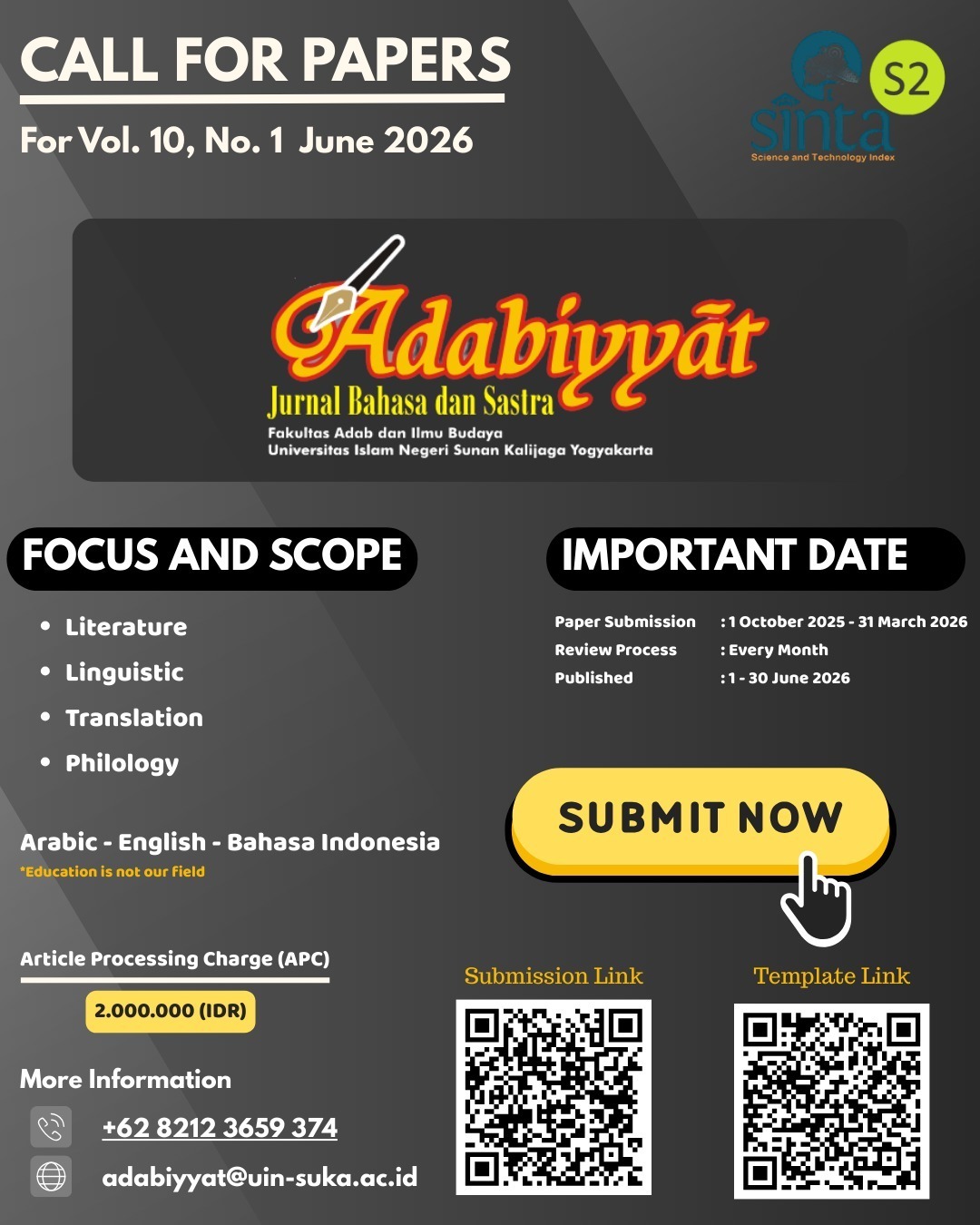REALISASI PEMENTINGAN INFORMASI PADA KALIMAT DALAM BAHASA INGGRIS
DOI:
https://doi.org/10.14421/ajbs.2014.13203الملخص
To achieve the goal of using language, the speaker of a language is structuring the linguistic construction as effective as possible. Moreover, he is able to modify the linguistic construction based on the prominence of the information. By so doing, language will meet its function, serving as the tool of delivering message to the interlocutor. However, there are many ways to mark the important information, such as supra-segmental, morphological, and syntactic ways. Syntactic marking of information packaging is called syntactic choice. Thus, this paper aims at describing the ways to package important information in English as one of widely spoken languages worldwide. This study belongs to descriptive qualitative study. The data were taken from realiable sources, written or spoken by native speakers. From the analysis, it is evident that English has several ways of structuring prominent information and resulting in some noncanonical constructions, namely topicalization, dislocation, cleft, existential, and so forth.
التنزيلات
المراجع
Alonso, Jose Carlos Prado 2007. Inversion in Written and Spoken Contemporary English. Disertasi Doktoral Universidade de Santiago de Compostea.
Anonim. “Extraposition”. Dalam http://en.wikipedia.org/wiki/Extraposition, diakses tanggal 10 Agustus 2014.
Cann, Ronnie. 2007. “Towards A Dynamic Account of Be in English.” Dalam: Comorovski, Ileana, dan von Heusinger, Klaus (Eds). 2007. Existence: Semantics and Syntax. Dordrecht: Springer.
Caro, Elena Martinez. 1993. “Non-SVO Constructions in English: Some Pragmatic and Functional Considerations”, dalam: Revista Alicantina de Estudios Ingleses, 6 (1):115—130.
Collins, Peter C. 2002. Cleft and Pseudo-Cleft Constructions in English. London: Routledge.
Creswell, Casandre. 2004. Syntactic Form and Discourse Function in Natural Language Generation. New York: Routledge.
Crystal, David. 2008. A Dictionary of Linguistics and Phonetics. Oxford: Blackwell.
Dahl, Roald. 2007. The Twits. London: Puffin Books. Durham, Mercedes. 2007. “Right Dislocation in North England: Frequency and Use—Perception Meets Reality.” Dalam: English World-Wide Vol. 32, no. 3, 2007.
Farrell, Patrick. 2005. Grammatical Relations. Oxford: Oxford University Press.
Finegan, Edward. 2008. Language: Its Structure and Use. Boston: Thomson Higher Education.
Foley, William A. 2007. “A Typology of Information Packaging in the Clause”. Dalam: Shopen, Timothy (Ed). 2007. Languange Typology and Syntactic Description. Cambridge: Cambridge University Press.
Keenan, Edward L dan Dryer, Matthew S. 2007. “Passive in the World’s Languages.” Dalam: Shopen, Timothy. 2007. Language Typology and Syntactic Description Volume I. Cambridge: Cambridge University Press.
Kerstin, S., dan W. Susanne. 2007. On Information Structure, Meaning, and Form. Amsterdam: John Benjamin Publishing.
Lambrecht, Knud. 2001. “Dislocation”. Dalam: Martin Haspelmath, Ekkehard König, Wulf Oesterreicher dan Wolfgang Raible (Eds). 2001. Language Typology and Language Universals: An International Handbook Volume 2. New York: Walter deGruyter.
Levin, Beth, dan Malka Rapaport Hovav. 2005. Argument Realization. Cambridge: Cambridge University Press.
Oktavianti, Ikmi Nur. 2012. “Kuasi-Kopula dalam Bahasa Inggris”. Tesis. Yogyakarta: Linguistik Universitas Gadjah Mada.
Penhallurick, John. 1984. “Full-Verb Inversion in English”, dalam: Australian Journal of Linguistics 4: 33--56.
Quirk, Randolph, Alfred Charles Gimson, dan Jeremy Warburg. 1972. The Use of English. London: Longman Group.
Sutopo, H.B. 2006. Metodologi Penelitian Kualitatif. Surakarta: Universitas Sebelas Maret Press.
UNC College of Arts and Sciences. Dalam http://www.writingcenter.unc.edu, diakses tanggal 10 Agustus 2014.
Verhaar, J.W.M. 2010. Asas-Asas Linguistik Umum. Yogyakarta: Gadjah Mada University Press.
التنزيلات
منشور
إصدار
القسم
الرخصة
- Adabiyyāt: Jurnal Bahasa dan Sastra publishes all articles entirely in full text.
- It is permissible for readers to download and to use it for scientific purposes and scientific dissemination.
- The author can re-publish the article that has been published by the Adabiyyāt: Jurnal Bahasa dan Sastra after obtaining written permission from the editor. This letter can be obtained by submitting a request letter for permission to republish the article to Adabiyyāt: Jurnal Bahasa dan Sastra via email adabiyyat@uin-suka.ac.id. In the second publication, the author is required to include information that the article was firstly published by the Adabiyyāt: Jurnal Bahasa dan Sastra.




















